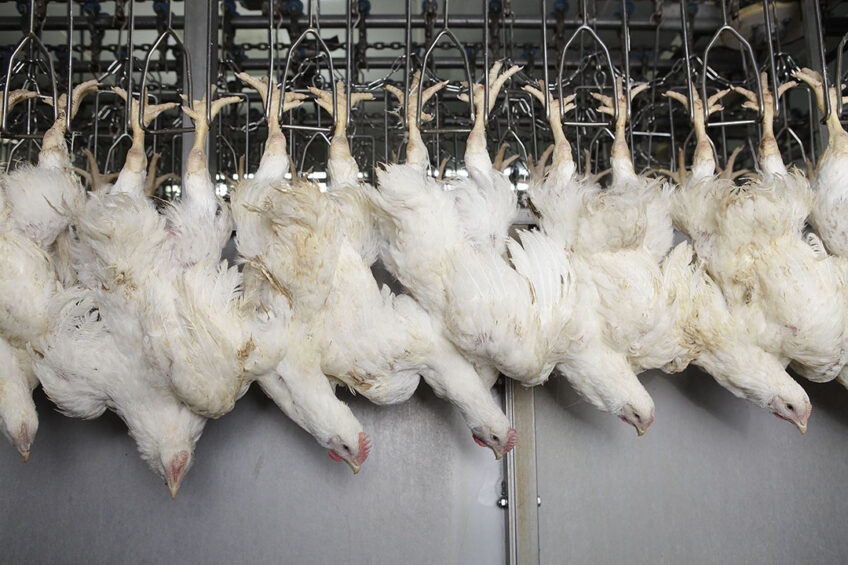Low-stress handling ensures good quality broiler meat

Low-stress handling is defined as using specific techniques in the approach, harvesting and handling of broilers in the period between leaving the production unit and arriving at the processing plant, to decrease stressors and avoid escalated fear and aggression.
The growing world population has increased the demand for meat production and has led to rapid growth in the scale of broiler enterprises globally. The intensive husbandry practised in broiler production units has meant that broilers have become exposed to stressors more frequently. According to the UN Food and Agriculture Organization (FAO) current global production of broilers is approaching 66 billion birds per annum.
As a result of the large number of individual broilers being processed, stressors, such as environmental temperatures and pre-slaughter handling, have a significant economic impact on the broiler industry. Environmental temperatures and pre-slaughter handling procedures and practices can affect the process of converting muscle to meat, compromise meat quality and impose varying degrees of stress upon the broilers, thereby affecting their welfare status, decreasing potential meat yield, and depreciating meat value due to haemorrhaging, bruising, broken bones, undesirable colour and water-holding capacity.
Dead on arrival
Furthermore, these stressors increase the number of broilers dead on arrival (DOA) at the processing plant which represents a total loss of economic value. The average frequency of DOA broilers, ranging from 0.5% to 5% with an average mortality rate of about 0.2-0.42%, corresponds with the complete loss of around 1.2-2.9 million broilers a year. Therefore, it is essential to consider low stress handling strategies in the period between leaving the production unit and arriving at the processing plant to ensure good quality broiler carcasses and lean meat, as well as prevent financial losses and welfare problems.
Harvesting and handling broilers
Harvesting and handling consist of manual or automatic catching of broilers and placing them in transport crates which are subsequently loaded onto vehicles and transported to a processing plant. Catching and loading are important processes because if broilers are injured, this will have a profound effect on their response to the rest of the journey to the processing plant. Appropriate harvesting and handling procedures are essential to reduce stress, mortality and trauma, such as haemorrhages, bruises, femur dislocation at the hip joint and fractures. The effects of stressors are also likely to be greater where the handling time between the production unit and processing plant is longer.
Automation of processes
The benefits of developing and adopting automatic broiler harvesting and handling include lower costs, less bird stress, with fewer bruises and injuries to broilers. Automatic harvesting and handling improve the working conditions of live haul personnel as well. Comparisons between hand-catching labour costs and estimated labour costs associated with operating an automatic system suggest savings of over 60%.
Transporting broilers to the processing plant
Transporting broilers from the production unit to the processing plant is associated with fear and stress and is considered one of the most critical periods with regard to the risk of dehydration. Although transport represents a brief period in the total lifespan of broilers, there are indications that it is a time when both mental and physical suffering can be considerable. The combination of stressors and the transport conditions are responsible for welfare issues during transport.
Broilers are also very likely to suffer from thermal stress in transit due to difficult close environmental control in the crates on the vehicles. Most vehicle ventilation is passive and impeded by the close stacking of adjacent crates. Broilers on the inside of a load may suffer hyperthermia, while those on the outside may experience hypothermia. The microclimate within the vehicle is a major contributor to both death and overall transport stress in broilers.
Prolonged food or water withdrawal for several hours during transport also leads to loss of live weight and loss of potential carcass yield. The actual loss varies depending on the holding conditions, particularly temperature, humidity, ventilation and whether both feed and water, or just feed, are withdrawn.
Limiting transport duration
The prevalence of dead broilers in journeys lasting less than four hours is 0.15% but for longer journeys (up to nine hours) it increases to up to 80%. Therefore, limiting journey times to four hours would save more than a quarter of a million broilers annually. It is further recommended to place broilers in transport crates at night or early morning, so they experience less stress. After transport, a suitable lairage period in proper holding areas with environmental control is necessary to reduce thermal stress in live broilers. However, short lairage times are recommended for broilers due to the low energy availability in metabolically-active birds who may have suffered physiological changes and body weight loss due to fasting during transport. Likewise, increased humidity reduces the effectiveness of panting and limits broilers’ ability to lose body heat. Thus, in summer it is recommended to reduce stocking density in crates to control the build-up of heat and humidity, and maintain airflow.
Preventing losses
The need for low-stress handling of broilers continues to mount due to the growing world population, and increased demand for good quality lean broiler meat while preventing financial losses and welfare problems. Automatic broiler harvesting and handling, shorter transport duration, placing broilers in transport crates at night or early in the morning, a suitable lairage period in proper holding areas with environmental control, and reducing stocking density in crates in summer, are some of the recommended low stress handling strategies to be applied in the period between leaving the production unit and arriving at the processing plant.












